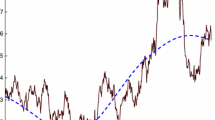Abstract
Mapping a locus controlling a quantitative genetic trait (e.g. blood pressure) to a specific genomic region is of considerable contemporary interest. Data on the quantitative trait under consideration and several codominant genetic markers with known genomic locations are collected from members of families and statistically analysed to estimate the recombination fraction, θ, between the putative quantitative trait locus and a genetic marker. One of the major complications in estimating θ for a quantitative trait in humans is the lack of haplotype information on members of families. We have devised a computationally simple two-stage method of estimation of θ in the absence of haplotypic information using the expectation-maximization (EM) algorithm. In the first stage, parameters of the quantitative trait locus (QTL) are estimated on the basis of data of a sample of unrelated individuals and a Bayes’s rule is used to classify each parent into a QTL genotypic class. In the second stage, we have proposed an EM algorithm for obtaining the maximum-likelihood estimate of θ based on data of informative families (which are identified upon inferring parental QTL genotypes performed in the first stage). The purpose of this paper is to investigate whether, instead of using genotypically ‘classified’ data of parents, the use of posterior probabilities of QT genotypes of parents at the second stage yields better estimators. We show, using simulated data, that the proposed procedure using posterior probabilities is statistically more efficient than our earlier classification procedure, although it is computationally heavier.
Similar content being viewed by others
References
Almasy L. and Blangero J. 1998 Multipoint quantitative trait linkage analysis in general pedigrees.Am. J. Hum. Genet. 62, 1198–1211.
Amos C. I. and Elston R. C. 1989 Robust methods for the detection of genetic linkage for quantitative data from pedigrees.Genet. Epidemiol. 6, 349–360.
Dempster A. P., Laird N. M. and Rubin D. B. 1977 Maximum likelihood from incomplete data via the EM algorithm.J. R. Stat. Soc. B39, 1–38.
Fergusson T. S. 1967Mathematical statistics: a decision-theoretic approach. Academic Press, New York.
Ghosh S. and Majumder P. P. 2000 Mapping quantitative trait loci via the EM algorithm and Bayesian classification.Genet. Epidemiol. 19, 97–126.
Goldgar D. E. 1990 Multipoint analysis of human quantitative genetic variation.Am. J. Hum. Genet. 47, 957–967.
Haley C. S. and Knott S. A. 1992 A simple regression method for mapping quantitative trait loci in line crosses using flanking markers.Heredity 69, 315–324.
Haseman J. K. and Elston R. C. 1972 The investigation of linkage between a quantitative trait and a marker locus.Behav. Genet. 2, 3–19.
Kruglyak L. and Lander E. S. 1995 A nonparametric approach for mapping quantitative trait loci.Genetics 139, 1421–1428.
Lander E. S. and Botstein D. 1989 Mapping Mendelian factors underlying quantitative traits using RFLP linkage maps.Genetics 121, 185–199.
Lincoln S. E., Daly M. J. and Lander E. S. 1993 MAPMAKER/ QTL version 1.1. http://www.genome.wi.mit.edu.
McLachlan G. J. and Krishnan T. 1997The EM algorithm and extensions. Wiley, New York.
Olson J. M. 1995 Robust multipoint linkage analysis: an extension of the Haseman-Elston method.Genet. Epidemiol. 12, 177–193.
Author information
Authors and Affiliations
Corresponding author
Rights and permissions
About this article
Cite this article
Ghosh, S., Majumder, P.P. An improved procedure of mapping a quantitative trait locus via the EM algorithm using posterior probabilities. J Genet 79, 47–53 (2000). https://doi.org/10.1007/BF02728945
Received:
Issue Date:
DOI: https://doi.org/10.1007/BF02728945




